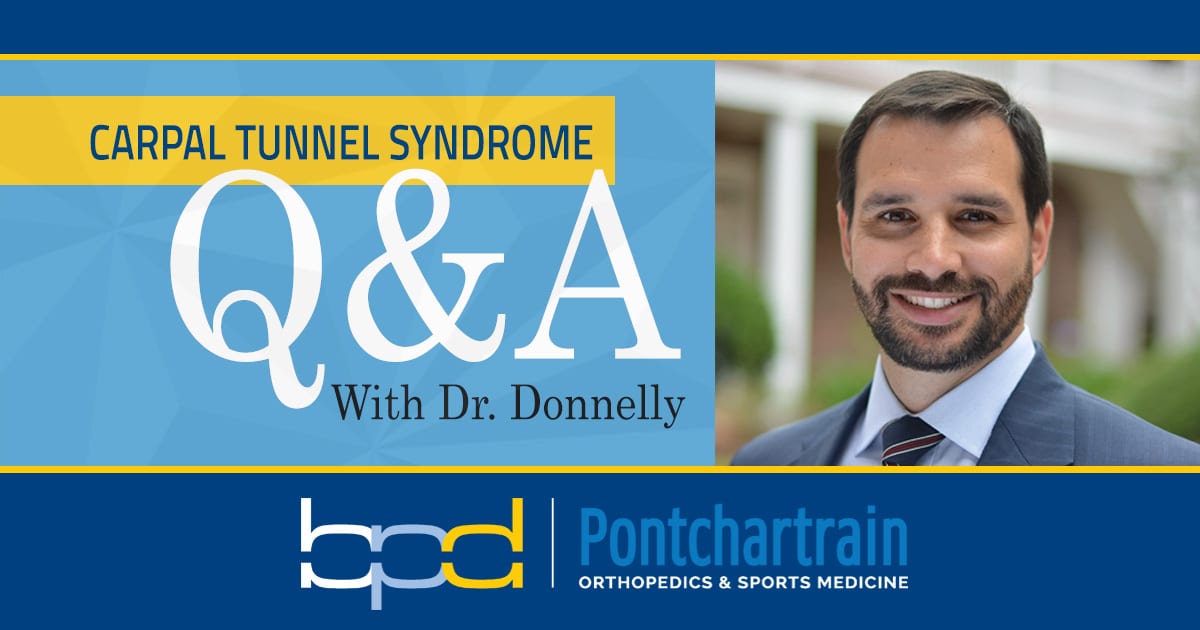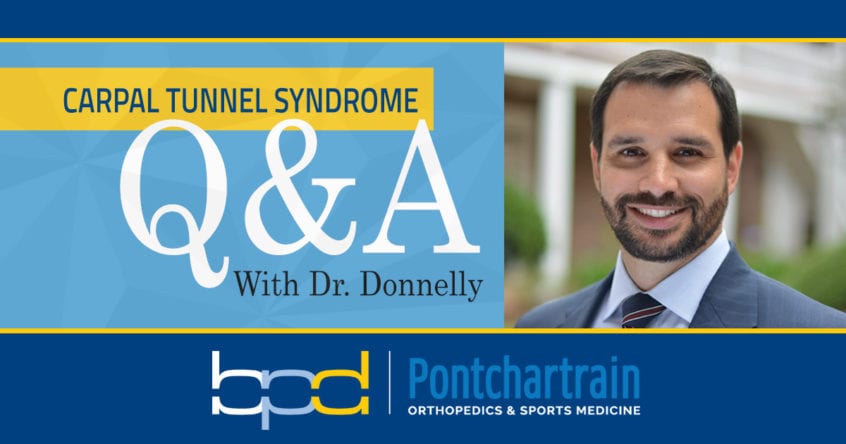
Carpal tunnel syndrome (CTS) affects as many as a third of all workers in the U.S., in particular those with jobs requiring repetitive hand movements. In today's post, Dr. Donnelly will answer several carpal tunnel syndrome questions that range from the symptoms and diagnosing of CTS, to treatment options, and the post-surgery long-term prognosis.
Symptoms & Diagnosing CTS
CTS occurs when the median nerve, which runs along with flexor tendons that bend your fingers, becomes pinched at the wrist. When the median nerve has been compressed, symptoms can include tingling, numbness, and/or general weakness in your hand or arm. The carpal tunnel syndrome questions below show how people can experience CTS in different ways.








You can most certainly get carpel on the other side; it’s not dominant-hand specific. At the same time, it has not been scientifically shown to be related to most keyboard work. Everybody thinks that keyboarding can cause CTS, but that hasn’t been proven to be true. One caveat: Heavy data entry, based on key strokes per minute, can be an occupational cause. Usually, however, it’s related to heavy vibrations, such as jack hammering.
To answer the first part of your question, a different keyboard position can definitely help with hand pain. It really depends on how you're using your hands. No part of the body likes to be in the same position for a long time. If you stand up all day, for instance, your feet will hurt. It’s the same thing with hands if you do a lot of typing, or a lot of holding. People are holding cell phones longer and longer, and that’s just an unnatural position. So switching hands, altering your grip or using a different avenue to get the same thing done may be helpful.
Nonsurgical Treatment of CTS
In carpal tunnel syndome’s earliest stages, simple things can have a big impact. Taking more frequent breaks to rest your hands, cold packs or avoiding certain activities may lessen your symptoms. The carpal tunnel syndrome questions below explore these and other nonsurgical treatment options.








Surgical Treatment of CTS
Surgery could be appropriate if symptoms become more severe or if your hand isn’t responding to other treatments. CTS surgery involves cutting the ligament pressing on your median nerve in order to relieve pressure. There are two techniques, endoscopic and open surgery. The endoscopic option involves using a tiny camera on a telescopic-like device to see inside the carpal tunnel. Dr. Donnelly then cuts the ligament through a small incision. Open surgery, as the name suggests, involves a larger incision in your palm to reveal the ligament. The carpal tunnel syndrome questions below cover the surgical treatment option.


In terms of long-term risks, the biggest is people who wait too long and then develop permanent damage to the nerve. If the nerve becomes severely compressed, you can get permanent sensory loss, as well as muscle weakness and even muscle loss. Both open (actually mini open) and endoscopic carpal tunnel release have a fairly short recovery. Soft dressings are worn for 4-5 days, followed by just a band-aid. Light activities are possible right away. The literature notes less palmar pain and earlier return to heavier use with the endoscopic technique.
Nevertheless, studies have shown at 6 weeks both groups have similar results, and using a mini-open approach has people returning back to work and avocations in a similar time frame to endoscopic.


The easiest thing to do for early carpal tunnel syndrome is taking an over-the-counter anti-inflammatory and wearing a standard wrist brace. Particularly at night, that can help. Aside from that, steroid injections are an option, but more often than not they do not offer lasting relief.
To address the risks of waiting, one problem with chronic nerve compression is it can cause some internal scarring that the surgery doesn’t always fix. Surgery takes external pressure off, but if there is scarring inside, the damage is already done. That pain or weakness doesn’t always go away.
Aside from bracing and other non-surgical treatment, the least expensive treatment would be surgical carpal tunnel release performed wide awake with a technique referred to as WALANT (Wide Awake, Local Anesthetic, No Tourniquet). Because no sedation is involved, there are no anesthesia fees. Lastly, controlling the symptoms will likely keep the CTS in check. We are unsure if there can be damage done to the nerve without symptoms being felt, but most opinions on the matter believe that if one is symptom free (no numbness, tingling, weakness etc), there is likely no ongoing damage to the carpal tunnel nerve.


Long Term Prognosis of CTS
CTS surgery has a remarkable high success rate of more than 90 percent. Many symptoms are quickly relieved, including tingling and numbness. Recovery doesn’t take long, either: The bandage covering your stitches can be removed in just a few days. The following carpal tunnel syndrome questions discuss the long term prognosis of CTS.




Recurrent carpal tunnel syndrome is uncommon. Usually, we’re only seeing it 15, 20, 25 years out from the initial surgery. There’s not too much to be done, however, to keep it from coming back on that kind of timeline.
The small group of people who develop scarring around the nerve can also have their symptoms come back. That’s much more challenging to correct surgically, just because of the scar tissue. Unfortunately, there’s nothing that can be done to prevent CTS. Surgery will correct the problem, but nothing has been proven to prevent it.
Have Carpal Tunnel Syndrome Questions We Didn’t Cover?
If you still have carpal tunnel syndrome questions about the diagnosis, treatment and prognosis for carpal tunnel syndrome, request an appointment with Dr. Donnelly. Following an evaluation, we will be able to discuss CTS and what can be done to relieve your pain.
About Dr. Brandon P. Donnelly, MD
 Dr. Brandon P. Donnelly is a board certified orthopedic surgeon with Pontchartrain Orthopedics & Sports Medicine. Dr. Donnelly completed his hand and microsurgery fellowship at the prestigious Philadelphia Hand to Shoulder Center. Dr. Donnelly treats all ages of patients in the greater New Orleans area for hand, wrist, and elbow conditions.
Dr. Brandon P. Donnelly is a board certified orthopedic surgeon with Pontchartrain Orthopedics & Sports Medicine. Dr. Donnelly completed his hand and microsurgery fellowship at the prestigious Philadelphia Hand to Shoulder Center. Dr. Donnelly treats all ages of patients in the greater New Orleans area for hand, wrist, and elbow conditions.
This site is not intended to and does not provide medical advice, professional diagnosis, opinion, treatment or services to you or to any other individual. Through this website and links to other websites, Brandon P. Donnelly, MD provides general information for educational purposes only. The content provided in this website and links, is not a substitute for medical care or treatment. You should not use this information in place of a consultation or the advice of your healthcare provider. Brandon P. Donnelly, MD is not liable or responsible for any advice, course of treatment, diagnosis or any other information, services or product you obtain through this site.

